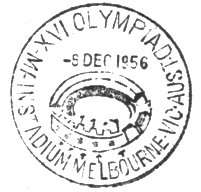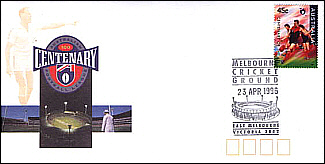|
|
|
Melbourne
Cricket Ground |
|

APM01166 |
The MCG, or the "Gee" as it is
affectionately known, is the "Mecca" for Australian Rules Football (along with
Australian Cricket.)
The record attendance at the ground
is 121,696 for the 1970 Carlton v Collingwood Grand Final. The more recent
building of the Great Southern Stand and restraints on patrons due to safety
factors, has seen the seating reduced to approximately 97,000. |
|
| Although
the Melbourne Cricket Club members were instrumental in the formation and
codification of Australian Football, the MCG was not initially allowed to be
used for football for fear that it would damage the wicket area.
Interestingly the same argument surfaces every
February and March when the cricket and football seasons overlap.
Football games were played in the parklands
beside the ground. A trial game against the police was played on the MCG in 1869
but it was not till 1879, after the formation of the VFA, that the first
official match was played on the ground. The formation of the breakaway VFL in
1897 has seen all Grand Finals played at the MCG since 1902. The only exception
was in 1991 when the Great Southern Stand was being built and the grounds
seating capacity was decreased and the game was played at Waverley.
|

APM23600
FDI on 43c MCG Stamp |
|
| In 1897 and 1924 the
Premiership was decided without a Grand Final match but by the leading team
after the home and away series.
Initially Melbourne Football Club had the ground
to themselves but ground rationalisation has meant that they were joined by
Richmond (1965), North Melbourne (1984) and Essendon (1992) to play all their
home games at the MCG. Collingwood since 1993 has played some home games at the
MCG while still playing some games at Victoria Park. The 2000 season and the
building of Colonial Stadium saw Essendon move their home to the new Stadium
while Collingwood finally left Victoria Park to play all their home games at the
MCG. |

|
|
Above is the AFL Centenary Cover with the Melbourne
Sheetlet Stamp and MCG PM on FDI of the stamp.
Cricket is the summer tenant, although more recently the MCG has been the
venue for rock concerts, rugby league, rugby union and soccer games.
1956 saw the staging of the
Olympics at the MCG. Between 1957 and 1960
The Dominican Republic issued 40
Olympic stamps with 32 commemorating the
Melbourne Games. There were also several surcharge overprints and Miniature
Sheets.
The ground also played an important part in the 2000 Sydney Olympics, at Stadium Australia, with the
Torch
Relay and hosting preliminary soccer matches.
On the 23rd September 2003, the MCG celebrated its 150th
Anniversary. Five covers were released by First Class Collectables. One cover
commemorated the
1956 Olympics
and another the
1996 Centenary Afl Grand Final.
Three covers had a cricket theme, one showing
Don Bradman,
another
Fred Spofforth
and the third showed
Tom Wills
and an aboriginal team commemorating the intricate
links between Indigenous Australians, the AFL, the MCC and the MCG.
Another cover was issued by
M&C Covers,
Melbourne. (The Cover Collector No.6).
The 2004 Athens Olympics saw the first
International Torch Relay with the Olympic Flame visiting all the cities that
had hosted the Modern Olympics. The relayed started in Melbourne on the 5th June
2004. The Torch entered the MCG at half time of the Essendon v Hawthorn Match
and was carried by Ron Barrassi and
Betty Cuthbert.
Other AFL support runners were Chris Judd and Chad Morrisson from the West Coast
Eagles, and Shane Wakelin and Shane Woewodin from Collingwood.
The
2006 Commonwealth Games were
held at the MCG from the 15-26th March. |
|
|
|
|